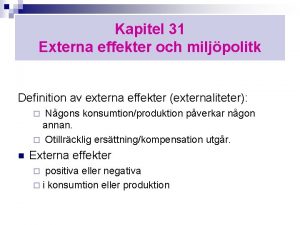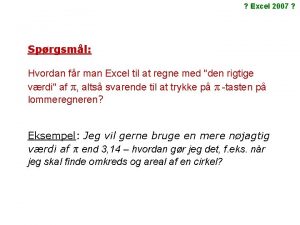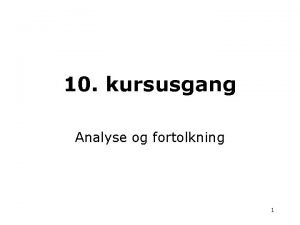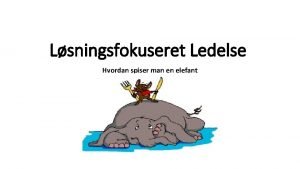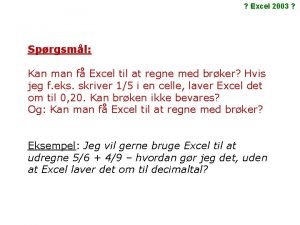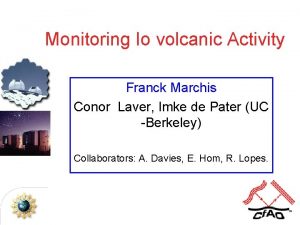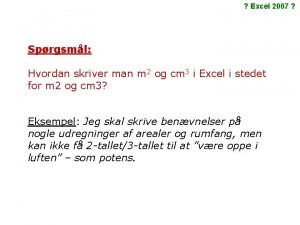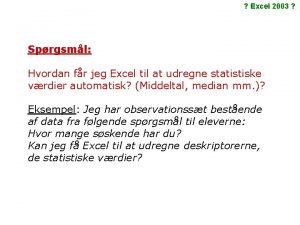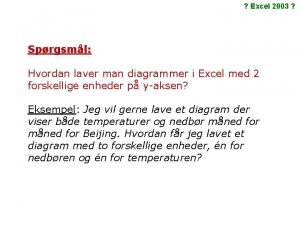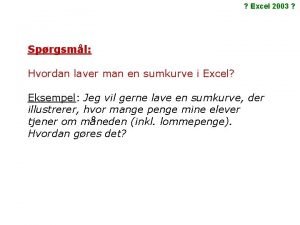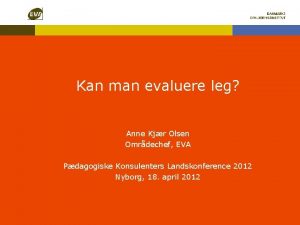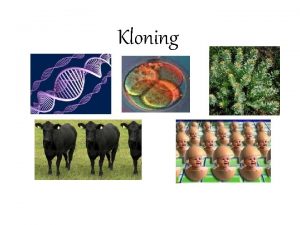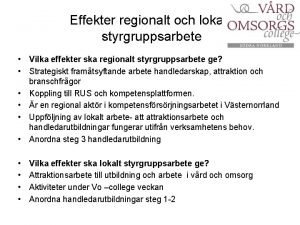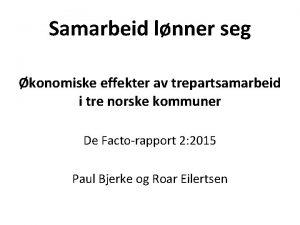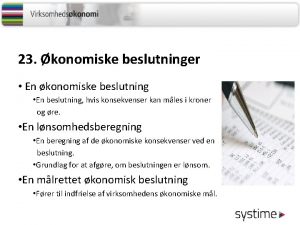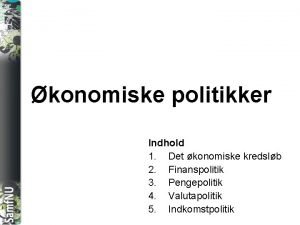Hvordan kan man evaluere de konomiske effekter af















- Slides: 15

Hvordan kan man evaluere de økonomiske effekter af kørselsafgifter - sammenligning af forskellige modeltilgange Ole Kveiborg Danmarks Transportforskning Projekt finansieret af Center for Logistik og godstransport(CLG) Trafikdage på Aalborg Universitet 29. august 2006 1

Why should we focus on HVF and the economic impacts? • Regulating freight transport through heavy vehicle fees on the agenda in many countries – Discussions of the impact on transport provider, transport buyer, the final consumer, international trade etc. – Spill-over effects between different sectors • Overall question: Why should e. g. Denmark introduce HVF? – In Germany there is a large number of transit trucks. Probably going from the Eurovignette to HVF is a good idea due to revenues raised from international haulliers – Can we expect the same outcome in a small country with only some transit transport ? • There are many (adverse) effects to keep from each other Trafikdage på Aalborg Universitet 29. august 2006 2

The relation between HVF and the (regional) economy • HVF changes transport costs – Immediate impact on transport providers • What can and will they do ? • Most of cost changes transferred to transport buyer • What are the impacts on the transport buyer ? – Freight transport from the market to the production plant increase price on intermediate inputs – Substitution to other intermediate inputs and value added factors (labour and capital) – Price increase on output, declining demand – Change in size of production (output reductions) Trafikdage på Aalborg Universitet 29. august 2006 3

The relation between HVF and the (regional) economy • The consequences for labour demand are – Substitution to value added factors – Output more expensive, production level decreases • In addition transport to the market increases product prices even further – Second order effects, demand declines, substitution, . . . • International competitive effects – Increasing prices on export markets due to • Increasing transport costs to the export markets (direct effect) • Increasing prices on intermediate inputs with increasing production costs Trafikdage på Aalborg Universitet 29. august 2006 4

The relation between HVF and the (regional) economy • Private households will be affected – Prices on commodities increase • Decreasing disposable income – Employment changes • Changes in disposable income • Revenues for the government – The use of revenue is very important – e. g. compensations/subsidies or tax deductions • Tax deductions – Increasing disposable income – Incentives to increase labour supply – Increasing demand for commodities Trafikdage på Aalborg Universitet 29. august 2006 5

Some model approaches • System dynamics models • I/O based models • CGE and SCGE models Trafikdage på Aalborg Universitet 29. august 2006 6

System dynamics models (ASTRA) Trafikdage på Aalborg Universitet 29. august 2006 7 • Linking of separate submodels • Central element is transport module (TRA) • Generalised costs (incl. HVF) calculated in TRA and fed into REM • Trade flows calculated using costs • HVF also directly leads to changes in macro-economic performance within regions and sectors

I/O models (LINE) 8 X 0 f 0 v 0’ x 0 v 0’e e’f 0 Fixed output coefficients bij=xij/xi in matrix B Fixed input coefficients bij=xij/xj in matrix B Trafikdage på Aalborg Universitet 29. august 2006 • The effect on industry output can be calculated using the Ghosh price multiplier (I-B)-1 • Changes in output prices calculated • Changes in output not calculated Changes in supply driven output calculated No relation between demand supply side effects

(S)CGE models • Theory based model • Fewer details • Modelling market imperfections • Endogenous production of transport Trafikdage på Aalborg Universitet 29. august 2006 9

Case studies • Comparison of – I/O approach from Germany – I/O-SCGE approach from Denmark – SCGE approach from Norway • Can illustrate common features and highlight important shortcommings and differences Trafikdage på Aalborg Universitet 29. august 2006 10

The German ’MAUT’ and the German economy • I/O based approach • Arbitrary HVF levels (€ 0. 127) • Exogenous changes in transport costs • Labour market effects – Ghosh forward price multiplier (average increases of 0. 11 per cent, but ranging from 0. 07 to 0. 18 per cent) – Behavioural effects in transport sector, cost increase of 4. 2 per cent – Leontief multiplier to calculate revenue effects – 45. 000 jobs created – no calculation of job losses due to price increases Trafikdage på Aalborg Universitet 29. august 2006 11

How will the Norwegian economy react to road pricing ? • PINGO/NEMO SCGE model • Marginal external cost pricing in long run – Initial mode shift towards sea transport – Long run efficiency improvements in road based transport lead to an increase – Lower income from transport taxes due to improved fuel efficiency • Negative welfare effects (household utility) – – Commodity price increases Even revenue redistribution does not lead to positive effects Producers surplus positive and negative depending on sector Welfare effects small compared to revenues Trafikdage på Aalborg Universitet 29. august 2006 12

National and international HVF and the Danish regional economy • A linearised SCGE model (I/O adapted) • Exogenous transport costs and arbitrary HVF • Large effects on export prices (0. 22 and 0. 58 percent) and exports (-0. 25 and – 0. 68 per cent) – Two scenarios, national and international HVF similar to German level – Average transport costs changes are 6 and 14 per cent – large regional differences • Negative employment effect • Disposable income decline in international scenario Disposable income decline and rise due to use of revenue through income taxes Trafikdage på Aalborg Universitet • 29. august 2006 13

Modelsammenligning - sammenfatning I/O - Germany SCGE – I/O Denmark SCGE - Norway Transport costs Exogenous Endogenous * Possible differentiation Potentially very large (transport model) Rather large (transport model) Limited * Cost changes Arbitrary (0. 127 € /KM) Arbitrary (0. 15 € /km) MCP (0. 176 to 1. 045 €/km) Behavioural effects Not included – fixed I/O coefficients Substitution of input factors, intermediates ”Market equilibrium” Market equilibrium Endogenous Partly endogenous Employment Only through revenue use (0. 13 % ) (– 0. 07 % and – 0. 10 %) Commodity prices 0. 33 % Transport costs 4. 2 % 6 - 14 % N/A Income/Welfare N/A -0. 04 % (foreign), 0. 19 % DK CS and externalities falls Trafikdage på Aalborg Universitet 29. august 2006 14

Konklusion • Der er stor interesse for viden om økonomiske konsekvenser af kørselsafgifter • Forskellige analyser og typer af værktøjer kan bidrage til at øge viden • Her har vi særligt fokus på de forskellige muligheder for analyser via modeller • Afvejning af detaljer overfor et egentligt teoretisk fundament • Vigtigt at beskrive agenternes tilpasning til de(n) nye situation • SCGE modeller bedst egnet til denne type af analyser • Men resultaterne er forholdsvis ens på trods af forskelligheder i modeltilgang samt analyseområde Trafikdage på Aalborg Universitet 29. august 2006 15
 What is man vs society
What is man vs society Kan ve kan yapıcı organlara ilişkin ameliyatlar
Kan ve kan yapıcı organlara ilişkin ameliyatlar Marginalprincipen
Marginalprincipen Effekter
Effekter Merkeverdi
Merkeverdi Pi i excel
Pi i excel Underrubrik eller manchet
Underrubrik eller manchet Kvales 5 analyseformer
Kvales 5 analyseformer Hvordan spiser man en elefant
Hvordan spiser man en elefant Brøk i excel
Brøk i excel Hvordan får man en elefant ind i et køleskab
Hvordan får man en elefant ind i et køleskab Hvordan laver man mosaik
Hvordan laver man mosaik Excel m 2
Excel m 2 Typetal
Typetal Lær excel 2007
Lær excel 2007 Sumkurve
Sumkurve


